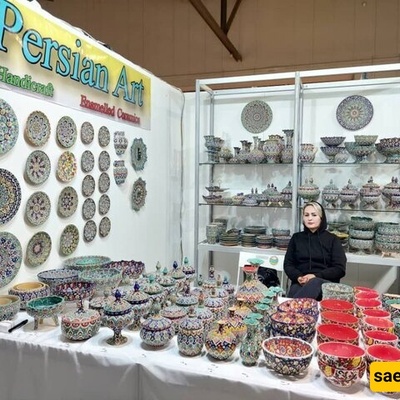Stone carving is an art in which delicate and beautiful creations emerge from the heart of the stone. Stay with Saed News to get to know this art.

Stone Carving Means Bringing Out a Delicate Work of Art from the Heart of a Rough, Lifeless Stone Slab.
Shaping and engraving stone by methods such as cutting, carving, scratching, and combining techniques for the purpose of making and decorating various objects or tools is called the art of stone carving. Due to their hardness, durability, resistance, and abundance in nature, stones are considered a primary raw material for producing many Iranian handicrafts. The art of stone carving in Persepolis (Takht-e Jamshid) represents a special philosophy and concept, which may be the most important reason it is considered an art. For example, the bas-relief of the battle between the lion and the bull alone symbolizes a myth and a deep philosophy.

There are two methods for carving away excess stone, the oldest being the grinding (abrasion) of the stone’s surface. By grinding the stone surface gradually downward, the desired image appears. Many precise grindings and polishing give the final surface a special quality. Surfaces made by stone carving are very smooth and delicate both visually and to the touch.
Stone carving in Iran began centuries before Christ with making tools for hunting animals and basic life implements, gradually reaching its peak of development and prosperity. Archaeological finds, including objects uncovered in excavations at the Yahya Hill near Kerman, indicate that this craft dates back to 4500 BCE. The discovery of these vessels shows that in those days, carving various functional and decorative items from green stone was common in Kerman — a type of stone still extracted and sent to Mashhad today. Generally, stone carving in ancient Iran was mostly dedicated to making agricultural tools, hunting implements, and animal skinning tools. Stone artifacts from residential caves such as the Kamarband or Huto Cave near Behshahr, dating back to 11,000 to 8,000 BCE, also attest to this. Stone also played a very important and fundamental role in constructing historical buildings and ancient monuments. Among the most important historical structures are the palaces from the Achaemenid era and the stone carvings from the Sassanid period. Persepolis is a prominent example of the stone-cutting industry during the Achaemenid era. For instance, over 600 intact and broken stone vessels were found in two treasury rooms of Persepolis, discovered by the scientific team from the University of Chicago. One of these vessels is a stone goblet with a base.

Because of features such as hardness, durability, resistance, abundance in nature, and naturalness, stones are heavily used in artworks and handicrafts. Many diverse types of stone can be found in Iran, each used in a specific place and for particular tasks based on its shape and texture. Each stone’s features are identified by its strength, color, transparency, veins, hardness, and how it breaks. Stones do not absorb color due to their texture and structure; only their surface can be painted temporarily. Naturally, stones come in colors like black, white, cream, yellow, beige, gray, pink, purple, burgundy, maroon, turquoise, green, lapis lazuli, brown, jade, and brick red.
Various stone carving tools include:
Wave chisels and joint chisels (for reducing excess and cutting stone),
Narrow engraving chisels (for creating lines and delicate work),
Tooth chisels (for removing surface excess),
Scraper chisels (for smoothing the base and background of designs, combined with scratching),
Hole chisels,
Various types of picks for rough surfaces, known as single-pick or double-pick techniques,
And compressor or double-headed picks for very rough surfaces.

How It Is Made
To make stone objects, first, large stone slabs extracted from mines are cut into three or four parts depending on the workshop’s demand. These stones at this stage are called "Angareh." Then, using a pickaxe, the stones are roughly shaped into the desired object. At this stage, the stone is called "Chaloor," "Kolang," or "Ghalveh." The subsequent steps are done by hand or on a special wheel. When working by hand, the chaloor is hollowed out using nails and thick rods, and to polish the outer surface, it is first filed and then smoothed with fabric sandpaper.
When using a stone carving machine, the bow-like part (with a string wrapped around a wooden axis and attached to the stone with pitch) is moved back and forth by the stonecarver’s hand, while the other hand holds a special hooked tool that cuts the stone. This device is fundamentally like a primitive fire drill and very similar to a lathe machine but stronger. In recent years, motorized machines have largely replaced traditional stone carving devices, especially in Qom.

Today, the two main centers of stone carving in Iran are Qom and Mashhad. Currently, in these cities, several individuals are engaged in different stages of stone extraction, carving, and engraving on stone.

